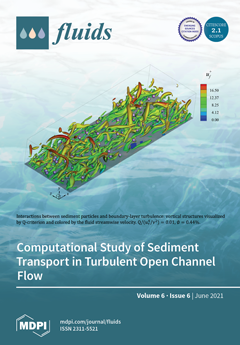Studies of flow through the human airway have shown that inhalation time (IT) and secondary flow structures can play important roles in particle deposition. However, the effects of varying IT in conjunction with the respiratory rate (RR) on airway flow remain unknown. Using
[...] Read more.
Studies of flow through the human airway have shown that inhalation time (IT) and secondary flow structures can play important roles in particle deposition. However, the effects of varying IT in conjunction with the respiratory rate (RR) on airway flow remain unknown. Using three-dimensional numerical simulations of oscillatory flow through an idealized airway model (consisting of a mouth, glottis, trachea, and symmetric double bifurcation) at a trachea Reynolds number (
) of 4200, we investigated how varying the ratio of IT to breathing time (BT) from 25% to 50% and RR from 10 breaths per minute (bpm) corresponding to a Womersley number (
) of 2.41 to 1000 bpm (
= 24.1) impacts airway flow characteristics. Irrespective of IT/BT, axial flow during inhalation at tracheal cross-sections was non-uniform for
= 2.41, as compared to centrally concentrated distribution for
= 24.1. For a given
and IT/BT, both axial and secondary (lateral) flow components unevenly split between left and right branches of a bifurcation. Irrespective of
, IT/BT and airway generation, lateral dispersion was a stronger transport mechanism than axial flow streaming. Discrepancy in the oscillatory flow relation
/
= 2
L/
D (
L = stroke length;
D = trachea diameter) was observed for IT/BT ≠ 50%, as
L changed with IT/BT. We developed a modified dimensionless stroke length term including IT/BT. While viscous forces and convective acceleration were dominant for lower
, unsteady acceleration was dominant for higher
.
Full article





